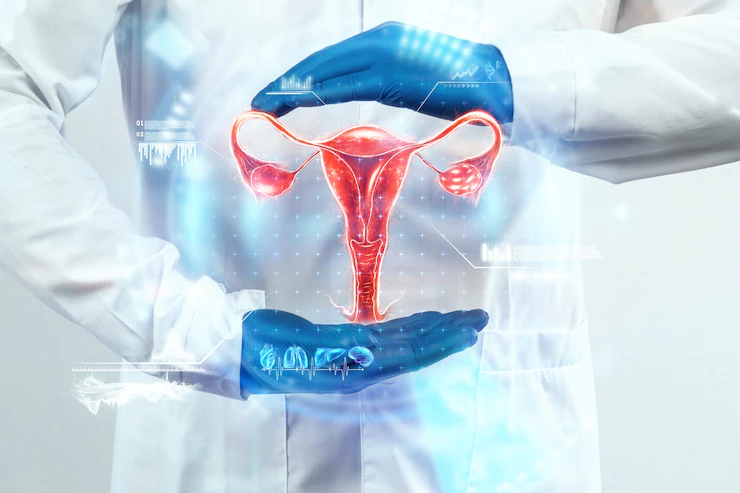Uterus fibroids are benign (not malignant) growths of the uterus myometrium. Because smooth muscle cells make up the majority of the uterus, they can expand as the pregnancy progresses and strongly contract after giving birth to facilitate vaginal delivery. Uterine fibroids may form beneath the endometrium (submucosal), myometrium (intramural), or serosa of the uterus (subserosal).
Uterus fibroids are quite frequent and affect about 25% of women between the ages of 18 and 45. Regardless of age, up to 80% of women who had their uteri surgically removed were found to have some fibroids. African American women have a higher risk of developing uterine fibroids than white women do.
Heredity, heavy alcohol use, and infertility are additional risk factors for uterine fibroids (never carried a pregnancy past 20 weeks).
Additionally, eating a lot of ham and red meat may increase your risk of getting fibroids, whilst eating a lot of fruits and vegetables may reduce your risk. This hasn’t, however, been proven beyond a shadow of a doubt. Regular usage of birth control pills appears to lower the risk of uterine fibroids.
Cause of Fibroid Uterus:
It is unknown what specifically causes fibroid growth. Some genetic flaws in smooth muscle cells enhance the risk, and although the precise mechanism of this is not well understood, fibroids also seem to be regulated by hormones.
Uterine fibroid symptoms
Uterine fibroids in women typically have no overt symptoms.
Those who experience symptoms may experience the following depending on the size, number, and location of the fibroids:
- Pelvic tightness or discomfort
- prolonged menstrual periods
- Constipation
- difficulty emptying your bladder
- frequent urination
- back or leg pain
Diagnosis
Large fibroids are often visible during a basic physical examination. The majority of fibroids may be found with ultrasonography, which is quick and easy to perform at a doctor’s office. A tool that can be used to find uterine fibroids is saline infusion sonohysterography. An office hysteroscopy is a fantastic way to discover uterine fibroids inside the uterus.
The fibroids’ exact location and size are the best-known facts. When choosing the optimal course of treatment, such as a myomectomy, embolization, or targeted ultrasound to remove uterine fibroids, it is a very valuable tool (see below). The second uterine illness that may be causing the symptoms is adenomyosis or leiomyosarcoma, and MRI can assist diagnose this condition (cancer of the uterine muscle). It must be used sparingly because it is the best and most expensive diagnostic approach.
Treatment for Uterine Fibroids
Your age, where your fibroids are located, whether you are suffering symptoms whether you want to get pregnant, and the best course of action for you will all be determined by these factors.
Waiting attentively: If you only experience minor symptoms or none at all, your doctor could advise you to wait it out. Fibroids do not lead to cancer and either grow slowly or not at all. They could shrink or disappear after menopause. Medications. The solution to your problems is fibroids medication. Although fibroids won’t go gone, several treatments may help them become less obvious. They also assist with symptoms like bleeding and discomfort. By utilizing oral contraceptives, bleeding can be minimized. Nonsteroidal anti-inflammatory drugs (NSAIDs) can be used to relieve pain, including ibuprofen and acetaminophen. In the event that persistent bleeding causes you to become anemic, vitamin and iron supplements can aid with energy.
The additional drugs consist of
- Oriahnn is the first oral medication substitute that the FDA has approved for the treatment of heavy menstrual bleeding. It also contains oestrogen and progestin, as well as the GnRH antagonist elagolix. Typically, taking the drug lowers bleeding by 50%.
- Oestrogen and progesterone are inhibited by gonadotropin-releasing hormone (GnRH) agonists, which results in menopause. Your fibroids may lessen as a result of this. Your doctor can decide to use this strategy before the operation.
- A progestin-releasing intrauterine device (IUD) implanted in your uterus helps manage heavy bleeding. It also aids in preventing pregnancy.
- The anti-hormone drug tranexamic acid (Cyklokapron, Lysteda) is used. You take it to reduce the flow on days when you bleed a lot.
Surgery
You could need surgery to treat your symptoms if they are moderate or severe. Several options include:
- Myomectomy. This procedure aims to remove fibroids while preserving healthy tissue. If you want to become pregnant in the future, this may be your best option. The two main abdominal surgeries and laparoscopy are just two of the many ways a myomectomy can be carried out.
- Ablation of the endometrium. The lining of your uterus may be removed or damaged by a surgeon using a laser, wire loops, hot water, electricity, microwaves, or freezing. It is possible to complete this quick procedure without spending the night. You won’t typically receive your period again and won’t be able to become pregnant.
- Uterine fibroid embolization (UFE). This technique involves injecting gel or plastic particles into nearby blood vessels to block the blood supply to your fibroids. The effect is that the fibroids shrink.
- Hysterectomy. Your uterus is completely removed during this surgery. The sole method to get rid of fibroids is this. Although it’s a serious procedure, your doctor has choices, such as opening up the abdomen or using a laparoscopy.

